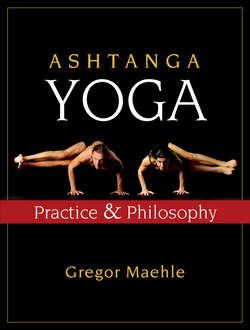Читать книгу Ashtanga Yoga - Gregor Maehle - Страница 198
На сайте Литреса книга снята с продажи.
Vinyasa Seven
ОглавлениеInhaling, jump through to a seated position.
At first you may execute this movement using momentum. With increased proficiency you will be able to jump through with little or no momentum while still clearing the floor. The key to effortless performance here is to connect the breath to the bandhas. As long as we are airborne in the jump, we must continue to inhale, as the inhalation has a lifting and carrying effect. Once the lift-through is complete we initiate the exhalation to lower down.
To learn this movement it should be divided into two clearly distinguishable separate phases. Phase 1 is hopping forward into an arm balance with the shoulders over the wrists, and the hips and folded legs lifted high. Phase 2 consists of letting the torso and legs slowly swing through the arms, using the shoulders as an axis. As you swing through, suck the feet up into the abdomen and the knees into the chest to clear the floor. With the last of the inhalation, straighten the legs into Dandasana, still suspended in the air. With the exhalation, slowly lower down like a helicopter. Performing the movement in this way will establish a firm connection between breath and bandhas. It will also strengthen the abdomen and the low back, preparing for the challenging backbends and leg-behind-head postures in the later sequences.
Sit in Dandasana for five breaths. Dandasana has no vinyasa count of its own: rather, the seventh vinyasa of Pashimottanasana is the state of Dandasana. Nevertheless Dandasana is the basic sitting posture. We will usually transit through Dandasana before and after each half vinyasa.
